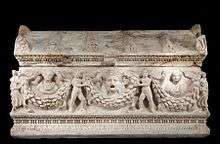Docimium
Docimium, Docimia or Docimeium (Greek: Δοκίμια and Δοκίμειον) was an ancient city of Phrygia, Asia Minor where there were famous marble quarries.[1]

History
This city, as appears from its coins – which bear the epigraph Δημος or Ιερα Συνκλητος Δοκιμεων Μακεδονεν – where the inhabitants are called Macedonians, may have been founded by Antigonos Dokimos.[2][3] The city's name in Greek is Romanized as Dokimeion, Dokimia Kome, Dokimaion, and later Dokimion.
Strabo places Docimium somewhere about Synnada: he calls it a village, and says that there is there a quarry of Synnadic stone,[4] as the Romans call it, but the people of the country call it Docimites and Docimaea; the quarry at first yielded only small pieces of the stone, but owing to the later efforts of the Romans large columns of one piece are taken out, which in variety come near the Alabastrites, so that, though the transport to the sea of such weights is troublesome, still both columns and slabs were brought to Rome of wondrous size and beauty. The red colors which streaked the white marble taken from the city's holy mountain were attributed to the drops of blood from the dying god Attis.[5] The word Docimaea (Δοκιμαίαν) in this passage of Strabo appears to be corrupt. It should be either Δοκιμαῖον or Δοκιμέα.
Strabo says that the plain of Synnada is about 60 stadia long, and beyond it is Docimium. We may, however, infer that he supposed Docimium to be not far from the limit of the plain. The Table makes it 32 M. P. between Synnada and Docimium, and Docimium is on the road from Synnada to Dorylaeum; but the number is certainly erroneous. The exact site of Docimium was a matter of some dispute until recently; it is now fixed at the modern Turkish town İscehisar, in Afyonkarahisar Province.[6]
Episcopal see
On this site have been found many Christian inscriptions, later than Constantine.
Docimium was a suffragan of Synnada in Phrygia Salutaris.
Six or seven bishops are known, from 344 to 879 (Lequien, Oriens Christianus, I, 853); another bishop is mentioned in an inscription.[2]
Docimium is included in the Catholic Church's list of titular sees.[7]
References

- Steph. B. s. v. Σύνναδα.
-

- Smith raises doubt whether the coins are genuine.
- Chisholm, Hugh, ed. (1911). . Encyclopædia Britannica. 15 (11th ed.). Cambridge University Press. p. 674.
- Robin Lane Fox, Pagans and Christians, p41
- Richard Talbert, Barrington Atlas of the Greek and Roman World, (ISBN 0-691-03169-X), Map 62 & notes.
- Annuario Pontificio 2013 (Libreria Editrice Vaticana, 2013 ISBN 978-88-209-9070-1), p. 882